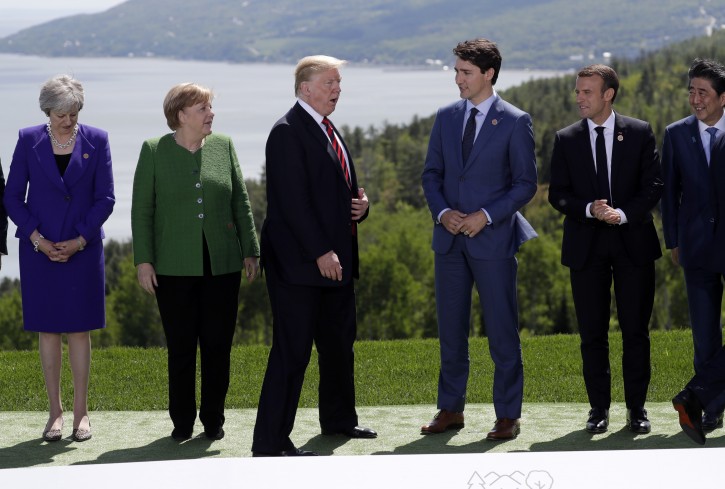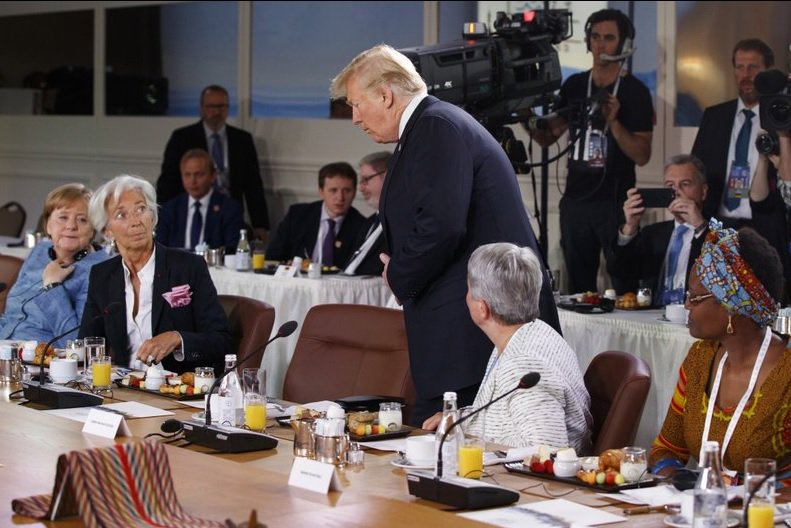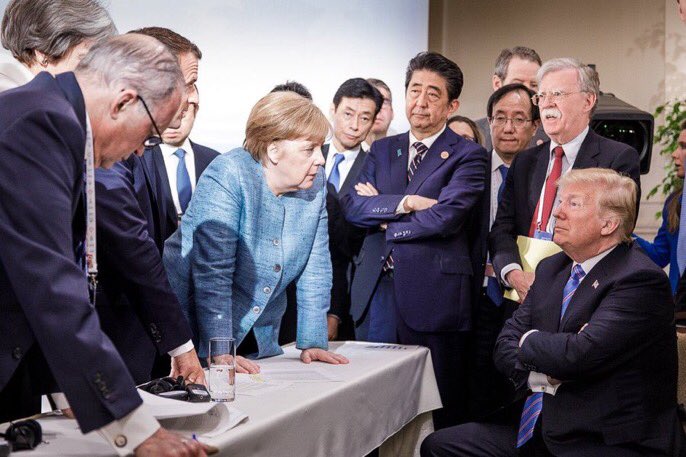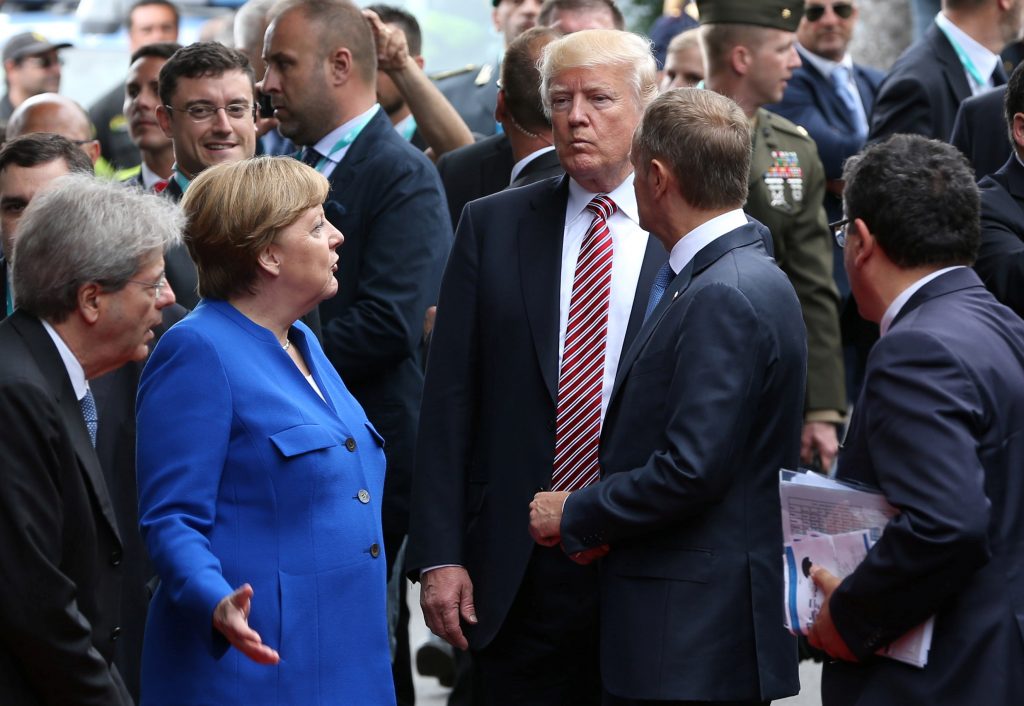
The following is a detailed 2018 time line for the republican President Donald Trump’s administration’s imposition of tariffs on China, Canada, Mexico, EU European countries, UK and other countries.
On June 7, 2018, a 2018 time line for US President Trump’s Tariffs was published by FASH455 Global Apparel & Textile Trade and Sourcing. I’ve footnoted a link to the entire report to access important documents.

2018 Time Line
Excerpts:
June 4, 2018: Secretary of Commerce Wilbur Ross concluded his two-day trade negotiation with China in Beijing. A White House statement said “the meetings focused on reducing the United States’ trade deficit by facilitating the supply of agricultural and energy products to meet China’s growing consumption needs, which will help support growth and employment in the United States. The US officials conveyed President Donald J. Trump’s clear goal for achieving a fair trading relationship with China.” While the announcement didn’t mention the next round, it says that the delegation will “receive guidance on the path forward.”

May 31, 2018: “President Trump signed two proclamations, which announced to impose Section 232 punitive tariffs on steel (25 percent ad valorem tariff) and aluminum (imposing a 10 percent ad valorem tariff) imports from Mexico, Canada, and the European Union as of June 1, 2018. The punitive tariffs for these three countries and regions were suspended since March 2018 because of the ongoing NAFTA renegotiation and trade talks. After President Trump’s announcement, Mexican government said it plans to retaliate with comparable penalties on U.S. products, including lamps, pork, fruit, cheese and flat steel.”
“Similarly, Canada said it would place tariffs on up to 16 billion Canadian dollars ($12.4 billion) worth of American goods, including steel and aluminum. Canada also filed a case against the U.S. tariff action at the World Trade Organization. Additionally, the EU trade commission said it would launch legal proceedings against the US in the WTO and “rebalance” the situation by targeting a list of US products with additional duties. This list includes American-made clothing (e.g., blue jeans, t-shirts) and footwear.”

May 29, 2018: “President Trump suddenly announced that the United States will impose a 25 percent tariff on $50 billion of goods imported from China containing industrially significant technology, including those related to the “Made in China 2025” program. The final list of covered imports will be announced by June 15, 2018. The announcement also said that the U.S. Trade Representative Office (USTR) will continue WTO dispute settlement against China originally initiated in March to address China’s discriminatory technology licensing requirements. Additionally, the United States will implement specific investment restrictions and enhanced export controls for Chinese persons and entities related to the acquisition of industrially significant technology. The list of restrictions and controls will be announced by June 30, 2018.”
May 23, 2018: “The U.S. Department of Commence (DOC) announced to self-initiate a Section 232 investigation against imports of automobiles, including SUVs, vans and light trucks, and automotive parts into the United States. DOC will determine whether imported automobiles “threaten to threaten to impair the national security.” DOC said that it would publish a notice in the Federal Register announcing a hearing date and inviting comment from industry and the public to assist in the investigation. DOC now has 270 days to conduct the investigation and prepare a report on its findings for submission to the President (by February 17, 2019).”

May 19, 2018: “A joint statement released by the White House said that the United States and China had led to an agreement for China to buy more goods and services, including “meaningful increases in U.S. agriculture and energy exports.” The statement also said that both sides attach importance to intellectual property protections, agreed to encourage two-way investment and to strive to create a fair, level playing field for competition, and agreed to engage at high levels on trade and investment issues. Additionally, the statement said that the United States would send a team to China to work out the details of the agreement. However, the statement did not contain a specific target for reducing the $375 billion trade deficits.“
May 14, 2018: “In a statement, the U.S. Trade Representative Robert Lighthizer said that the United States, Mexico, and Canada would continue to engage in the NAFTA renegotiation. However, the Trump administration missed an informal deadline that had been set by House Speaker Paul Ryan to get a revamped NAFTA to Congress in time for lawmakers to vote on in 2018 under the Trade Promotion Authority (TPA). Significant disagreements remained among the three countries regarding the auto rules of origin, the five-year sunset clauses and the investor-state dispute settlement provisions in the agreement.”

April 30, 2018: “President Trump issued two proclamations regarding his decision to impose punitive tariffs on imports of steel and aluminum based on the result of the 232 investigation. According to the proclamations, the tariff exemptions for Canada, Mexico, and the member countries of the European Union will be extended through May 31, 2018, to allow a continuation of discussions. The tariff exemptions for Argentina, Australia, and Brazil will be continued indefinitely while the U.S. works to finalize agreements in principle it has reached with these countries. And South Korea has been permanently exempted from the steel tariff based on a recent agreement reached between the two countries. However, Aluminum imports from South Korea are subject to the additional tariff on that product as of May 1.”
April 27, 2018: “The U.S. Trade Representative Office (USTR) released its annual Special 301 Report, which identifies trading partners that deemed “do not adequately or effectively protect and enforce intellectual property (IP) rights or otherwise deny market access to U.S. innovators and creators that rely on protection of their IP rights.” In the report, USTR identified 36 countries on the Priority Watch List or Watch List, up from 34 in 2017. China is on the Priority Watch List for the 14th consecutive year. USTR expressed concerns about China’s “Longstanding and new IP concerns merit increased attention, including China’s coercive technology transfer practices, range of impediments to effective IP enforcement, and widespread infringing activity—including trade secret theft, rampant online piracy, and counterfeit manufacturing.”

April 13, 2018, “the Treasury Department released its semi-annual report on currency practices of major trading partners. Once again, the report does NOT label China a “currency manipulator.” However, the report warns that China’s economic development was going in an “increasingly non-market direction.” The report also newly added India to the currency monitoring list, which already includes China, Japan, South Korea, Germany, and Switzerland.”
April 12, 2018, “When meeting with Republicans from farm states, President Trump directed his advisors to examine if the United States could negotiate its way back into the Trans-Pacific Partnership (TPP), which he walked away in 2017. Many argue that TPP would be economic and strategic leverage with China, which isn’t a TPP member. In his tweet on April 12, Trump said that “Would only join TPP if the deal were substantially better than the deal offered to Pres. Obama. We already have BILATERAL deals with six of the eleven nations in TPP, and are working to make a deal with the biggest of those nations, Japan, who has hit us hard on trade for years!” However, other TPP members expressed skepticism about the United States returning to the trade pact.”

April 5, 2018, “President Trump announced that he has instructed the Office of the U.S. Trade Representative (USTR) to consider $100 billion additional retaliatory tariffs on China, in response to China’s own retaliation against the Section 301 tariffs announced in late March. In a statement released the next day, USTR confirms the proposed new measures. USTR also says that any additional tariffs proposed will be subject to a similar public comment process as the proposed tariffs announced on April 3, 2018. No tariffs will go into effect until the respective process is complete.”
April 3, 2018, “USTR released the proposed list of Chinese products to be subject to the retaliatory tariff under the Section 301 action. The proposed list covers approximately 1,300 separate tariff lines and will undergo further review in a public notice and comment process, including a hearing (scheduled at around May 15, 2018). The USTR statement says it will make a final decision on whether to implement the proposed tariff action after the whole process.”

March 30, 2018, “the U.S. Trade Representative Office (USTR) released its 2018 National Trade Estimate Report, an annual report documenting foreign trade and investment barriers facing American exports around the world. This year’s report again includes technical barriers, such as product standards and testing, labeling, and certification requirements; sanitary and phytosanitary barriers, which include measures used to ensure that foods and beverages are safe for consumers and to protect animals and plants from pests and diseases; and barriers to exports of telecommunication goods and services. Further, the report cites new data localization policies and other digital practices in Indonesia, Nigeria, Vietnam and Thailand as “key barriers to digital trade,” in addition to reiterating concerns with China and others.”
March 29. 2018, “based on the results of an out-of-cycle review of the eligibility of Rwanda, Tanzania, and Uganda for trade preferences under the African Growth and Opportunity Act (AGOA), USTR has determined that Rwanda is not making sufficient progress toward the elimination of barriers to U.S. trade and investment. The US will intend to suspend Rwanda’s duty-free treatment for all AGOA-eligible apparel products in 60 days. In March 2017, the U.S. association representing used clothing exporters, the Secondary Materials and Recycled Textiles Association (SMART), filed a case with the Office of the U.S. Trade Representative (USTR) challenging the policies that limit used clothing imports in Kenya, Rwanda, Tanzania, and Uganda. Kenya, Tanzania, and Uganda resolved the issue in 2017.”

March 28, 2018, “the U.S. Trade Representative Office (USTR) announced the U.S. and South Korea have reached an agreement in principle on an improved U.S.-South Korea Free Trade Agreement (KORUS).Modifications of the KORUS will include an extended tariff phaseout schedule for U.S. tariffs on trucks, improved U.S. auto market access to South Korea, Customs improvement and pharmaceutical Reimbursements. USTR also confirms that South Korea will be exempted from the Section 232 tariffs on steel and aluminum.”
March 26, 2018: “USTR filed a WTO case against China’s discriminatory technology licensing requirements(DS542). The US claimed that China’s measures appear to be inconsistent with Articles 3, 28.1(a) and (b) and 28.2 of the Trade-Related Intellectual Property Rights Agreement (TRIPS). As of April 8, 2018, the European Union, Japan, Ukraine and Saudi Arabia have requested to join the dispute as third parties. According to the WTO rule, China shall enter into consultation with the US no later than April 26, 2018. If the dispute is not resolved by May 25, 2018 (i.e., 60 days after the request for consultation), the United States may request a WTO panel.”

March 22, 2018, “President Trump announced his decisions on the actions the Administration will take in response to China’s unfair trade practices covered in the USTR Section 301 investigation of China’s Acts, Policies, and Practices Related to Technology Transfer, Intellectual Property, and Innovation. U.S. Trade Representative Robert Lighthizer initiated the investigation in August 2017 at the direction of President Trump. In the Memorandum he signed, President Trump directed the US Trade Representative to level tariffs on about $50 billion worth of Chinese imports.”
March 22, 2018, President Trump issued an announcement, which authorized the modification of the Section 232 tariffs on steel and aluminum imports to suspend the tariffs for certain countries (Argentina, Australia, Brazil, Canada, Mexico, members of the European Union and South Korea) until May 1, 2018. The announcement also says that by May 1, 2018, President Trump will decide whether to continue to exempt these countries from the tariffs, based on the status of the discussions on the “long-term alternative means to address the threatened impairment to U.S. national security”

March 20, 2018, “President Trump requests U.S. Congress to extend the Trade Promotion Authority (TPA) by three years. The current TPA (granted in 2015) applies to trade agreements reached before July 1, 2018.”
March 8, 2018, “President Trump issued two proclamations which intend to impose additional tariffs on steel (25%) and aluminum (10%), based on national security justifications (section 232 investigation). The tariffs proclaimed took effect on March 23, 2018.”
March 6, 2018, “Gary Cohn (anti-tariffs) resigned as Whitehouse Chief Economic Advisor. Meanwhile, Peter Navarro (pro-tariffs) was promoted to become Whitehouse chief trade advisor.”

February 28, 2018, “the US Trade Reprehensive Office (USTR) released the 2018 Trade Policy Agenda. The report outlines the Trump Administration’s 4 trade priorities: support national security, strengthen the U.S. economy, enforce and defend U.S. trade laws, and strengthen the multilateral trading system.”
January 22, 2018, “U.S. Trade Representative Robert Lighthizer announced that President Trump has approved recommendations to provide relief to U.S. manufacturers and impose safeguard tariffs on imported residential washing machines and solar cells and modules, based on the investigations, findings, and recommendations of the independent, bipartisan U.S. International Trade Commission (ITC).”

January 2018, “the U.S. Trade Representative Office submitted its annual report on China’s WTO Compliance to U.S. Congress. The report says that “It seems clear that the United States erred in supporting China’s entry into the WTO on terms that have proven to be ineffective in securing China’s embrace of an open, market-orientated trade regime.”
Link to entire report plus links to documents: FASH455 Global Apparel & Textile Trade and Sourcing
The body language in the photos is telling.
LikeLiked by 1 person
Dear Rugby843,
They are only telling President Trump what any one of us would love to be able to say to him. In the photo where the German Chancellor Angela Merkel is staring down at President Trump with his crossed arms, it is only John Bolton who is doing the talking. All I can say is, God help us all.
Hugs, Gronda
LikeLiked by 1 person
Wondered if you saw this: https://www.facebook.com/vicenews/videos/201720797134030/
LikeLiked by 1 person
Dear Rugby843,
Thanks for sharing this Vice News video on teachers in Oklahoma. It reflects the education issues for other states as well. This should be an advertisement of why folks who care about education shouldn’t vote for republican candidates who reflect the thinking of the Oklahoma state lawmakers.
Hugs, Gronda
LikeLike
Some will make a great deal of money out of this and others will accumulate political capital.
In the case of the former it will not be the ordinary American; in the case of the latter it will certainly not be the USA.
LikeLiked by 1 person
Dear Roger,
The USA will lose on all fronts which is inevitable when it is being led by a President who acts like a loser.
Hugs, Gronda
LikeLiked by 1 person
History suggests that very few nations decline in an heroic and dignified manner. The damage comes from within. Those who cannot unite the peoples often being the main cause.
LikeLiked by 1 person